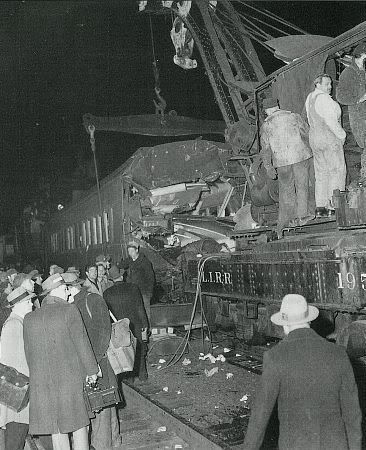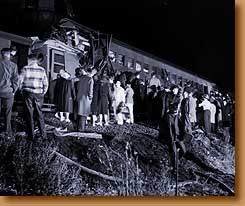 |
BusTalk
A Community Discussing Buses and Bus Operations Worldwide!
|
| View previous topic :: View next topic |
| Author |
Message |
Mr. Linsky
BusTalk's Offical Welcoming Committee

Joined: 16 Apr 2007
Posts: 5071
Location: BRENTWOOD, CA. - WOODMERE, N.Y.
|
 Posted: Sun Sep 14, 2008 5:49 pm Post subject: 'METROLINK ACCIDENT COULD HAVE BEEN AVOIDED' Posted: Sun Sep 14, 2008 5:49 pm Post subject: 'METROLINK ACCIDENT COULD HAVE BEEN AVOIDED' |
 |
|
Control devices could have prevented Metrolink crash, experts say
Mel Melcon / Los Angeles Times
Metrolink spokeswoman Denise Tyrell announced Saturday that preliminary evidence indicates that the train's engineer may have been responsible for the crash, saying, "We want to be honest."
The NTSB for decades has recommended collision-avoidance devices for corridors where passenger and freight trains use the same track. Railroads say the technology costs too much and isn't reliable.
By Dan Weikel and Steve Hymon, Los Angeles Times Staff Writers
September 14, 2008
Friday's disastrous collision that took the lives of at least 25 people might have been prevented if Metrolink and the region's freight railroads had installed sophisticated warning and control devices, according to safety experts who have been calling for such improvements for decades.
The National Transportation Safety Board, which investigates crashes and recommends ways to avoid them, began calling for the technology 30 years ago, after a train wreck in Louisiana. The safety board has repeatedly advocated the technology for high-risk corridors where freight and passenger trains operate side by side.
Southern California has more freight trains and commuter trains sharing tracks than any other place in the United States. But railroads and commuter lines here have not installed the technology, which is in use in parts of the Northeast and on routes between Chicago and Detroit.
Railroad officials have said the collision avoidance systems, known as positive train control, cost too much and are not yet reliable enough to install nationwide. That response frustrates safety experts.
"I'm not surprised that once again there has been a terrible, preventable train collision," said Barry M. Sweedler, a former senior director of the NTSB, who retired after 31 years. "It's extremely frustrating. They know what to do to solve these things."
COMMENT
After you have read above of the type of sophisticated systems that are talked of to prevent trains from passing red signals, and how much these devices would cost to install throughout our national railway network, I want you to think about this;
As far back as eighty years ago, the New York City subway system installed (at every traffic signal) a simple device in which, upon the signal turning to red, a 'T' bar would rise from the track to throw the brakes without human intervention.
This device, which amounts to a childs toy as campared to what they have in mind, could of saved the twenty five lives lost this last Friday!
We seem to be going backwards!
Photos by L. A. Times reporters.
Mr.Linsky - Green Bus Lines. Inc., Jamaica, NY

 |
|
| Back to top |
|
 |
Mr. Linsky
BusTalk's Offical Welcoming Committee

Joined: 16 Apr 2007
Posts: 5071
Location: BRENTWOOD, CA. - WOODMERE, N.Y.
|
 Posted: Mon Sep 15, 2008 3:38 pm Post subject: Posted: Mon Sep 15, 2008 3:38 pm Post subject: |
 |
|
Metrolink's grim record of fatalities
Only N.J.'s far-busier commuter rail has had more deaths since '99.
By Steve Hymon, Los Angeles Times Staff Writer
September 15, 2008
Metrolink has amassed the most fatalities among commuter railroads of similar size in the United States over the last decade, a statistic boosted in part by three deadly train collisions in the past five years, according to federal reports.
Cars and pedestrians at the 464 street-level crossings on Metrolink's right of way are a key factor in the fatalities, but the agency also stands out from some counterparts in how much it shares tracks with freight trains.
The cause of Friday's accident is yet to be determined, but investigators are focusing on a series of signals that should have warned the train's engineer to wait for a freight train to move off a shared track west of Chatsworth.
From 1999 through June 30 of this year, 47 people died in incidents involving Metrolink trains, according to Federal Railroad Administration records. That number does not include the 25 people killed in Friday's collision, the woman who died after her car was struck by a Metrolink train in Corona the same afternoon and a suicide by a pedestrian earlier this month. Those bring the total to at least 74 deaths.
The only commuter rail agency with more deaths than Metrolink is New Jersey Transit, whose trains travel six times as many miles as Metrolink trains on an annual basis and carry five times as many passengers. New Jersey Transit amassed at least 79 deaths through June 30. Since then, the railway has had at least one additional fatality, according to media reports.
Conversely, several larger commuter lines had fewer fatalities in the same time span. For example, the Chicago-area Metra trains, which last year traveled four times as many miles and carried seven times the number of passengers, had been involved in 59 fatalities from January 1999 through June, according to the data. Metra also suffered one fatality in a crash since then.
Other larger commuter rail agencies that have seen fewer fatalities than Metrolink include New York's Long Island Rail Road, the Massachusetts Bay Transit Authority that serves the Boston area and SEPTA, whose trains operate in the Philadelphia area.
"The figure I think is unfortunately misleading," said Keith Millhouse, the vice chairman of the Metrolink board of directors. "I don't think you can necessarily say or draw conclusions that these numbers necessarily reflect Metrolink's safety record."
He said the 11 deaths in the Glendale crash in 2005 were the "act of a convicted murderer" who parked his SUV on the track. And he pointed out that many of the other deaths were the result of people and cars trespassing on or crossing the tracks.
Federal records show that 20 people, most of them in vehicles, have been killed in accidents at street crossings with Metrolink trains since 1999. That is higher than other similar commuter rail agencies, except Metra, which had 22 such deaths. Metrolink is believed to have more grade crossings than similar railroads, particularly older established lines on the East Coast, where bridges and under-crossings are more common.
Metrolink also had a streak of multiple-fatality crashes in the last five years. In 2003, a freight train that failed to stop at a signal slammed into a Metrolink train in Placentia, killing three passengers. In 2005, 11 people died when a Metrolink train struck an SUV that had been deliberately parked on the tracks in Glendale, causing a collision with a second Metrolink train and a sidelined freight locomotive. The driver of the SUV was convicted of 11 counts of murder in June.
Warren Flatau, a Federal Railroad Administration spokesman, said that it's difficult to compare commuter railroads because of their different sizes, operating environments and the nature of crashes.
He noted that the 2003 and 2005 accidents were not the fault of Metrolink. Although Flatau said that his agency was "not in the business of boosterism," he praised Metrolink for being the first commuter rail agency to purchase train cars with technology to help them better absorb crashes. He also said Metrolink should be credited for trying to cordon off tracks from surrounding streets and neighborhoods.
Metrolink shares the majority of its 388 miles of track across six counties with freight trains. The rail service was stitched together by sharing agreements or by purchasing freight lines, often on the condition that freight haulers could keep using them. Service began in 1992.
Ross Capon, executive director of the National Assn. of Railroad Passengers, called Metrolink's two previous crashes "plain bad luck."
"When you create a commuter railroad service and you have lots of grade crossings and you have a lot of high speeds, and it's a fairly new service, it's not like Chicago where these trains have been running since the beginning of time," he said. "I think that part of it is the populace getting accustomed to fast and frequent trains in places where they didn't used to exist."
Capon said that Friday's accident should spur railroads to implement automated systems, known as positive train control, that can correct for human errors and stop trains before it's too late.
"They always want to make it anybody's fault beside their own," said Ed Pfiester, a Los Angeles-based attorney who specializes in railroad litigation and was involved in lawsuits stemming from the 2003 crash and is representing passengers in the 2005 crash.
"I just don't think they are managing it like they should in light of the kind of territory they run," he added. "They need better surveillance and security on grade crossings."
In 2006, a Metrolink train slammed into a car driven by Maureen Osborn, 76, killing her instantly near the intersection of Buena Vista Street and San Fernando Road in Glendale. Metrolink officials said Osborn was trying to beat the train.
The accident happened exactly three years after another at the same crossing, when a train hit a truck stopped on the tracks -- killing the driver and a train passenger.
Osborn's son Jim has long argued that his mother wasn't trying to race the train but was confused by the combination of traffic signals and railroad crossing lights in the area.
He believes Metrolink often shifts blame to motorists, ignoring more fundamental problems.
"Because my mom made a mistake, she's dead," said Osborn, an engineer who lives in Ann Arbor, Mich. "Metrolink doesn't fix problems. They leave them alone and let them grow into big problems."
COMMENTS
The article also mentions the number of fatalities suffered from all causes by the major U.S. commuter railroads since 1999 as follows;
Metra, Chicago; 60, New Jersey Transit; 80, Metro North, New York; 22, Long Island Rail Road; 40, SEPTA, Philadelphia; 21, MBTA, Boston; 41, Tri County, South Florida; 28, Metrolink, Southern California; 74, Caltrans, Bay Area; 41, MARC, Matyland; 6.
I remember vividly the 1950 Long Island Rail Road crash that occured on the Jamaica bound tracks between Kew Gardens and Richmond Hill on the eve of Thanksgiving that took 85 lives - how could I forget it? we lived only four blocks away!
My father, a surgeon, rushed to Jamaica Hospital to care for the wounded -it was a horrible scene that I will never forget.
It was after this crash, in which a speeding passenger train carrying homebound cummuters smashed in and through a stopped train ahead of it, that the Long Island installed bright red electric lamps at the rear of each train (in place of Kerosene) and painted the fronts and rears of all cars in luminescent orange.
An interesting bit of trivia; despite its trials and tribulations through the years, the Long Island Rail Road, to my knowledge, is the oldest in the country and has never changed its name since 1834!
Photos of 1950 crash courtesy of The Richmond Hill Historic Society.
Mr. Linsky - Green Bus Lines, Inc., Jamaica, NY
  |
|
| Back to top |
|
 |
|
|
You cannot post new topics in this forum
You cannot reply to topics in this forum
You cannot edit your posts in this forum
You cannot delete your posts in this forum
You cannot vote in polls in this forum
You can attach files in this forum
You can download files in this forum
|
Powered by phpBB © 2001, 2005 phpBB Group
|






